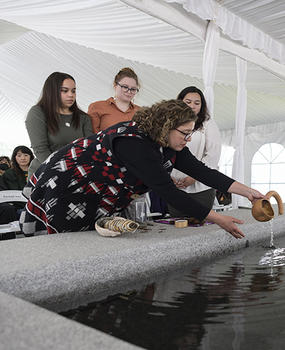
Kye Farrow had previously walked through the Enslaved People of George Mason Memorial, and felt proud.
Farrow, BA History ’19, MS Management ’20, was one of the five Mason students whose research into the enslaved children of George Mason IV led to the construction of the memorial, which is the cornerstone of the reimagined Wilkins Plaza on George Mason University’s Fairfax Campus.
But on Monday, as several hundred people assembled on the plaza for the monument’s dedication, Farrow, who would later speak at the event, said he was “just happy overall.”
“Studying history is what makes history not repeat,” Farrow said. “Being aware of history is what makes people have informed decisions and do things from a thoughtful perspective. So to have the opportunity to learn about the namesake of our university and for what it means to the student body, that’s the biggest thing for me.”
The event on Wilkins Plaza, named for Roger Wilkins, the late Black former civil rights leader, Pulitzer Prize-winning journalist and beloved Mason professor, was uplifting and reflective, and kicked off Mason's 50th anniversary celebration.
Mason President Gregory Washington called it “a landmark day for the university,” and praised the students who were involved in the original research — Farrow; Alexis Bracey, BA Global Affairs ’19; Ayman Fatima, BS Systems Engineering, BA Government and International Politics ’21; Farhaj Murshed, BS Statistics ’20; and Elizabeth Perez-Garcia, BS Criminology, Law, and Society ’19.
Those students joined a project launched in the summer of 2017 by Wendi Manuel-Scott, a professor of integrated studies and history; Benedict Carton, a faculty member in History and Art History; and Mason alum George Oberle, Mason’s history librarian and a term faculty member in the Department of History and Art History.
All are leaders in the Center for Mason Legacies, an interdisciplinary and collaborative research center established by the University Library and College of Humanities and Social Sciences that encourages student research to preserve and examine the legacy of George Mason IV. The university’s namesake penned the Virginia Declaration of Rights but also enslaved more than 100 people at his home, Gunston Hall.

“The Enslaved People of George Mason Memorial represents so much about who we are as a university,” Washington said. “Inquisitive students who seek truth, undergraduate research programs that support these academic pursuits, faculty who collaborate, nurture and challenge our students, and a university community fueled by the shared thrill of discovery and the determination to turn their efforts into positive and sustainable change. … We grow wiser from examining our full truths, no matter how complicated or messy or discomforting they might be.”
Added Trishana Bowden, vice president of Mason’s office of Advancement and Alumni Relations, and president of the George Mason University Foundation: “This project has allowed our students to educate us, to enlighten us and to teach us how to keep moving forward, and how to remember our past.”
That included a water ceremony in which water from the Potomac River was poured into the Wilkins Plaza fountain, which contains stones in a pattern that symbolize an African custom of gathering and prayer. The ceremony, led by Gabrielle Tayac, an associate professor of public history and a Piscataway tribal citizen, also acknowledged that the land on which the university was built was originally inhabited by indigenous people.
"The memorial for all of us was about replacing erased history through silenced voices of the enslaved people in relation to and in dialogue with the traditional voices,” Manuel-Scott said. “We hope that folk who visit the memorial, that it forces them to think about the relationship between the past and the present."
Rev. Jeffrey O. Johnson Sr., pastor at nearby Mount Calvary Baptist Church, said he hopes the memorial will push other universities and institutions to move forward and “that we will not bring the founding fathers down, but in pride and dignity, we will lift their servants up.”

